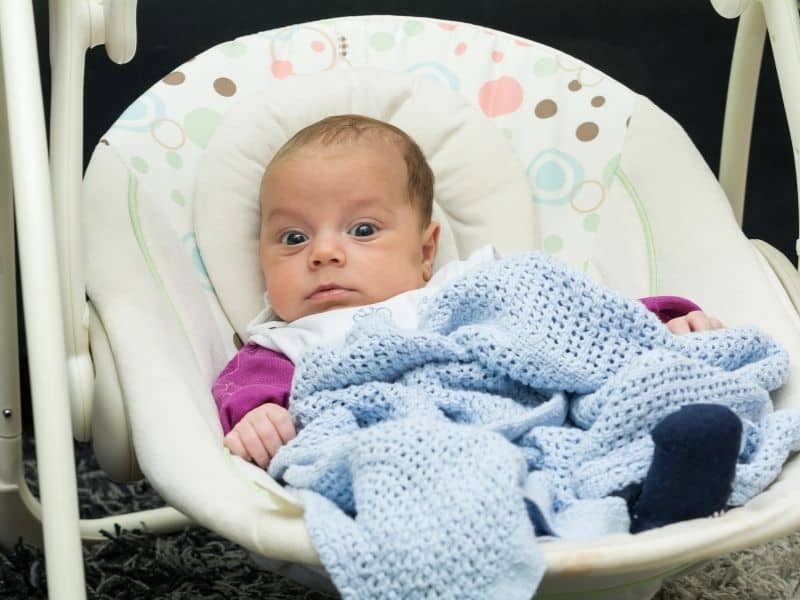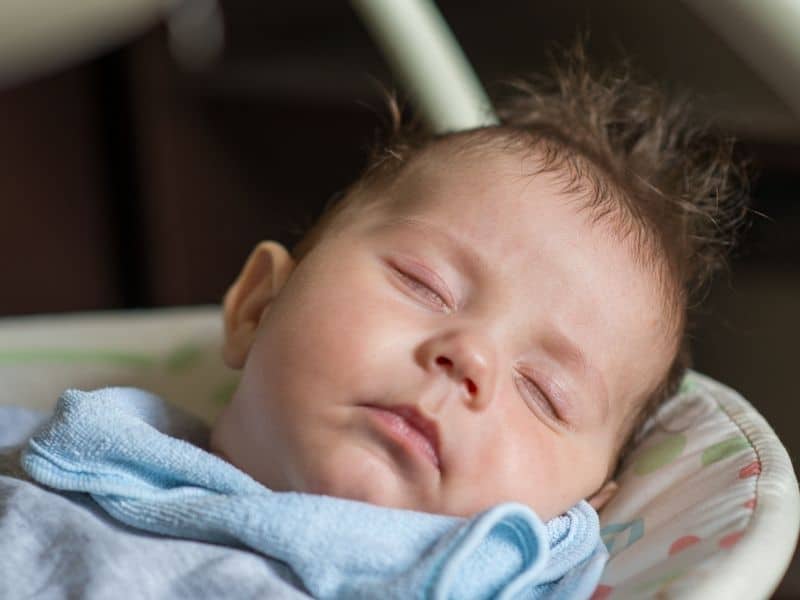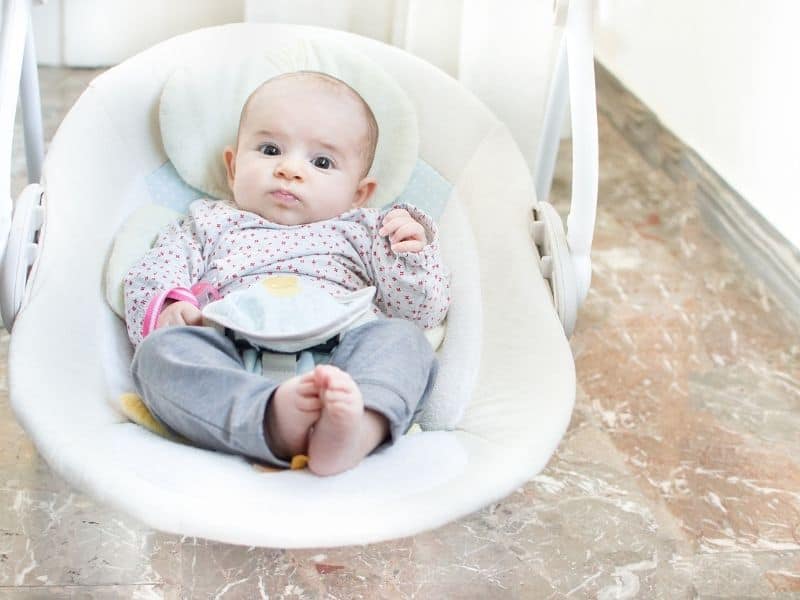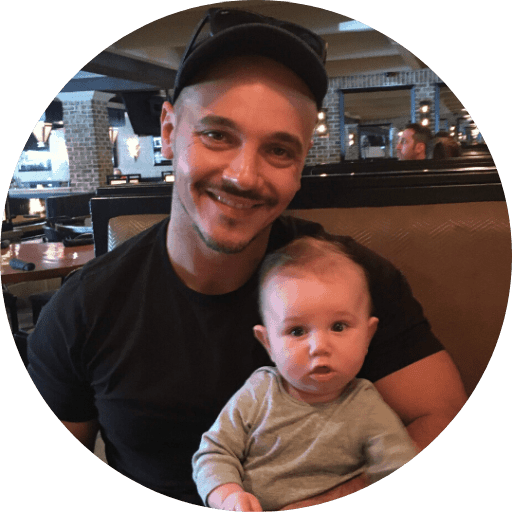If you’re a mom or a dad, we’ll start by alleviating any worries about your kids’ safety.
NO, baby swings DO NOT cause brain damage.

However, there are some concerns about baby swings we believe you should know about.
When I set out to answer this question, I was dumbfounded by the lack of precise information on the topic of baby swings and potential brain damage.
Most of the posts I read left me with more questions than they answered.
This guide is different.
I made sure that the information I present are not mere opinions but an in-depth analysis of every aspect of the topic.
After all, it’s a complex question that deserves serious answers.
Can Swings Cause Shaken Baby Syndrome or Brain Damage?
To answer the most pressing question, the answer is NO! Baby Swings DON’T cause Shaken Baby Syndrome or brain damage, their motion is simply not intense enough.
But more on this later.
If you read nothing else beyond this point, just make sure that the baby swing you purchase is approved by the Consumer Product Safety Commission (CPSC).
The CPSC sets strict guidelines for baby swings, and all models approved for sale in North America have been tested for safety – as long as the product works correctly and instructions are properly followed!
If you want to see those guidelines, be sure to check the CPSC’s website after going through this article.
In the meantime, let’s dive deep into this important subject and try to understand how Shaken Baby syndrome (SBS) happens, and why baby swings are safe.
The logic behind the question
If you’re reading this, your probably heard (or read) that swings can potentially cause brain damage but don’t understand exactly how.
Let’s cut right to the crux of things.
The question “do baby swings cause brain damage?” is actually this question:
“Can the motion of baby swings be intense enough to cause the kind of damage to brain cells that we see in Shaken Baby Syndrome (SBS)?”
That’s a mouthful, I know, but it’s the simplest way I can put it.
To answer it conclusively, I’ll break the question down and put it back together.
PART 1: Defining Shaken Baby Syndrome
Shaken Baby Syndrome is brain damage that happens as a result of the baby being shaken with enough force to cause swelling, bruising, and even bleeding.
It’s a typical result of intense to-and-fro motion, with or without a head strike.
A baby’s head is disproportionate in size compared to the body. In most babies, the had is about 25 %of the body weight.

Furthermore, their neck muscles are weak and the blood vessels fragile and prone to shearing.
That paints a picture of a vulnerable brain that can be damaged by even a few seconds of violent shaking.
In a baby with SBS, the blood vessels that feed the brain are torn and bleed into the skull cavity. This creates pressure and causes additional brain damage.
Now, that sounds scary…I know.
I used direct language to make the points clear – you should NEVER lose your cool and shake the baby.
With that said, this kind of damage is specific to the VIOLENT back and forth motion. The forces at work here are much greater than if they trip and fall.
In short – most of the time, Shaken Baby Syndrom happens as a result of frustrated parents abusing their child. Don’t obsess over it, just make a mental note of all the points I made here.
Signs and symptoms of Shaken Baby Syndrome
Shaken Baby Syndrome (SBS), also known as Abusive Head Trauma (AHT), is a combination of signs and symptoms that can lead to severe brain damage for babies.
These signs consist of one or more of the following:
- Lethargy
- High levels of irritability
- A decrease in appetite or vomiting for unknown reasons
- Grab-type bruises on your kids’ arms or chest
- Breathing difficulties
- A decrease in consciousness levels
- Seizures
- Your baby’s inability to lift their head
- The inability of eyes to focus or track movement
- Unequal size of pupils
It’s quite a concern that the American Academy of Pediatrics (AAP) describes SBS as “a subset of AHT with injuries having the potential to result in death or permanent neurologic disability.”
SBS Side Note: These are just some of the most common symptoms of SBS. Click here to see the complete list.
Part 2: Gray and white matter of the baby brain
Let’s take a moment here to go a step further and actually explain how brain damage happens in the cases of Shaken Baby Syndrome.
The human brain consists of gray and white matter.
Gray matter (substantia grisea) is heavier. It’s where most of the information processing happens. It makes for about 40 % of the brain but consumes over 90% of the oxygen.
White matter (substantia alba) is lighter. Its main role is to facilitate communication between the different areas of the grey matter.
Because of the difference in densities, they react to acceleration differently.
This part is crucial to understand because most of the information you can find out there implies that brain damage happens because the brain hits the skull.
Skull-to-brain contact is only a part of the story
The difference in the densities between white and gray matter causes them to move at different velocities puts strain on the paper-thin blood vessels in the baby’s head (less than a millimeter).
Why is this important?
Because that’s exactly what happens when a baby is shaken and it’s what would’ve happened in a swing if the acceleration and deceleration is intense enough.
An outlier opinion
I’ve read everything there is to read on the topic and have only found one doctor that thinks cradles and baby swings might be behind some of the shaken baby syndrome and SIDS cases with inconclusive causes.
It’s Dr. Cheang Chee Keong of the Raja Permaisuri Bainun Hospital.
He admits to the fact that there are no studies to back up the fear that a baby swing might cause brain damage but warns that it’s theoretically possible.
My take
I’m not a doctor and I wouldn’t dream of offering anything that can be interpreted as medical advice.
What I’m about to say is just how I approached the subject when deciding what’s safe for my kids.
I thought about the SNOO smart sleeper.
That’s the bassinet my wife and I used for both our kids and it’s officially advertised as the “safest baby bed.” It calms the baby down by rocking and swaying.
SNOO has now reached over 100 million logged sleep hours without a single case of SIDS or baby injury. It has five intensity levels (baseline plus 4) and level 4 is pretty intense.
If the movement was the problem, there’d be no way (statistically or practically) for the SNOO to reach the safety milestone.
You can read my detailed review of the SNOO here.
So, what could be the cause behind the unexplained SIDS if it’s not movement?
I’ll put a pin in this one and get back to it in a moment.
The frustrating part
No matter how unlikely, the potential of a baby swing to cause brain damage is so widespread of a concert that it’s shocking there are no conclusive studies on the topic.
It’s frustrating that we had to broach the subject from a layman’s perspective.

No matter how deep you dig, you come away with the conclusion that there’s no proof to support the claim that a baby swing can cause shaken baby syndrome or brain damage.
To sum up – the short answer to the question, “Do baby swings cause brain damage?” is no.
The slightly longer answer would be, “Nott as far as we can tell based on all the data we looked at, but conclusive research is definitely needed.”
The real dangers of baby swings
The shaken baby syndrome stories are so gruesome that a parent might miss the real dangers of baby swings.
And that’s leaving your baby to sleep in it.
For at least a year, as their neck muscles form, a baby shouldn’t sleep on any surface that’s nor flat and firm. That excludes bouncy chairs, car seats, and swings.
What’s so dangerous about falling asleep in a baby swing?
A baby swing will have your kind in an inclined or even semi-upright position. If they fall asleep like that, it raises the suffocation risk dramatically. I have a detailed post about whether or not it is safe for babies to sleep in a swing if you want to find out more.
The reasons go back to what we already explained – the heavy head and the weak neck muscles.
What to do instead?
The AAP (American Academy of Pediatrics) advises transferring the little one to a crib or bassinet before they fall asleep.
Proof in studies (aka. don’t kill the messenger)
I know that what I said about sleeping in a baby swing might come as surprise because babies tend to love the swing. For some of them, that’s the only place where they fall asleep.
If you’re fuming right now and thinking, “What does this guy know?” let me take a step back and look at some research on the topic of baby swing safety.
Infant deaths in baby swings and car seats
According to a 2019 study, approximately 35 babies dye each year while sleeping in a device designed for sitting. Most of those happen in car seats (62.9%) with swing being a close second (35%).
AAP also looked at the data for the 2009-2012 period and found a serious number of “swing-related incidents” that didn’t result in serious injury or death (over 320).
Safe use of a baby swing
Instead of going on and on about all the ways the joy that is baby swing can turn into a nightmare, let me resume what we said to give you a few tips on how to avoid the risks:
- If you notice your baby falling asleep in a swing, transfer them to a firm, flat surface designed for baby sleep (like a bassinet or crib)
- Until they’re four months old, your baby should only use the swing in the most-reclined position
- Check the swing is stable and make sure it can’t tip
- Get rid of any overheads or toy mobiles that a baby can potentially reach and pull down
- Follow the weight limits of a baby swing to a T
- Check the cradle of the swing while in motion – it should stay mostly flat
Final thoughts
When used as instructed, baby swings are safe and the movement isn’t intense enough to pose a serious brain damage risk or head trauma.
To put it simply – in and of themselves baby swings are not dangerous. It’s the improper use that changes that.
If you honor what we went over today, they’ll be as much of a joy for you as they are for the baby.
Baby Swing FAQ
What Do Baby Swings Do?
First of all, its job is to hold your little one when you can’t. It gives your arms a much-needed break!
It also provides motion stimulation which helps babies feel relaxed or even stop crying. A little playful swinging can even aid with fussiness and keep your infant entertained!
How Do Baby Swings Work?
They’re pretty much stationary sitting devices with a frame and powered mechanism. These components work together so infants can swing in a seated position!
There’s also another type called a cradle swing. It’s an infant swing intended to be used while your child lies flat!
Does a Baby Swing Help Your Baby Sleep?
Using a swing to help your baby sleep is a no-no because it can get dangerous once your baby falls asleep!
Your baby sleeping on the swing can have their head flop forward. This obstructs breathing and can cause positional asphyxiation!
Safety Tip: Due to this risk, you should also avoid having your infant fall asleep in a car seat, bouncing chair, or even a stroller!
Can Baby Swings Make Babies Sick?
They can, but this occurs due to repeated use of a swing for hours at a time.
We advise you to NOT use a baby swing for long periods!
Why Does My Baby Get Sick From Using the Swing for Too Long?
We’ve mentioned that a very young child still has a fragile brain. They can’t handle prolonged exposure to swinging motions!
Aside from getting sick, your baby could even experience motor issues or brain damage.
Are Swings Bad for Babies Brain?
We’ve covered the dangers of the prolonged use of baby swings.
Generally speaking, though, swings aren’t bad for babies’ brains.
The most significant thing any parent can do is take heed of safety precautions and strictly follow directions. This minimizes any danger by a HUGE margin!
Paul is a passionate dad who founded Upside Dad to share his parenting journey with other new parents. He graduated from Concordia University and worked as a test engineer for over a decade. Paul loves dad jokes and craft beer.
Learn more about Paul and Upside Dad here.
